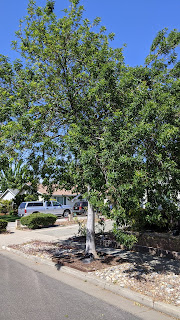Chinese elm - Ulmus parvifolia

Chinese elm are native to Asia. Growing to 50'-60' tall it is probably the most-planted elm in the world and are very common in Sunnyvale. It is the hardest wood of all the elms and is favored for making chisel handles. Most mature trees have a smooth bark with a mottled pattern. Chinese elm in Raynor Park, Sunnyvale The single-toothed leaves are 1"-2" long and 1" broad, and may remain on the branches as late as December Where to find them: There is a long ro w of Chinese elms in Raynor Park just behind the Recreation Building and surrounding the round “skateboard bowl” (a former fountain structure?). There is also a row of Chinese elms in Ortega Park near the Emperor Way parking lot. They are also very common along San Aleso Ave and Floyd Ave.










